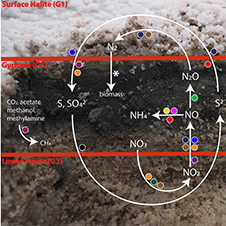Link to online paper: https://journals.asm.org/doi/full/10.1128/msystems.00846-22
Abstract
The Bonneville Salt Flats (BSF) appear to be entirely desolate when viewed from above, but they host rich microbial communities just below the surface salt crust. In this study, we investigated the metabolic potential of the BSF microbial ecosystem. The predicted and measured metabolic activities provide new insights into the ecosystem functions of evaporite landscapes and are an important analog for potential subsurface microbial ecosystems on ancient and modern Mars. Hypersaline and evaporite systems have been investigated previously as astrobiological analogs for Mars and other salty celestial bodies, but these studies have generally focused on aquatic systems and cultivation-dependent approaches. Here, we present an ecosystem-level examination of metabolic pathways within the shallow subsurface of evaporites. We detected aerobic and anaerobic respiration as well as methanogenesis in BSF sediments. Metagenome-assembled genomes of diverse bacteria and archaea encode a remarkable diversity of metabolic pathways, including those associated with carbon fixation, carbon monoxide oxidation, acetogenesis, methanogenesis, sulfide oxidation, denitrification, and nitrogen fixation. These results demonstrate the potential for multiple energy sources and metabolic pathways in BSF and highlight the possibility for vibrant microbial ecosystems in the shallow subsurface of evaporites. IMPORTANCE The Bonneville Salt Flats is a unique ecosystem created from 10,000 years of desiccation and serves as an important natural laboratory for the investigation of the habitability of salty, halite, and gypsum-rich environments. Here, we show that gypsum-rich mineral deposits host a surprising diversity of organisms and appear to play a key role in stimulating the microbial cycling of sulfur and nitrogen compounds. This work highlights how diverse microbial communities within the shallow subsurface sediments are capable of maintaining an active and sustainable ecosystem, even though the surface salt crust appears to be completely devoid of life.
